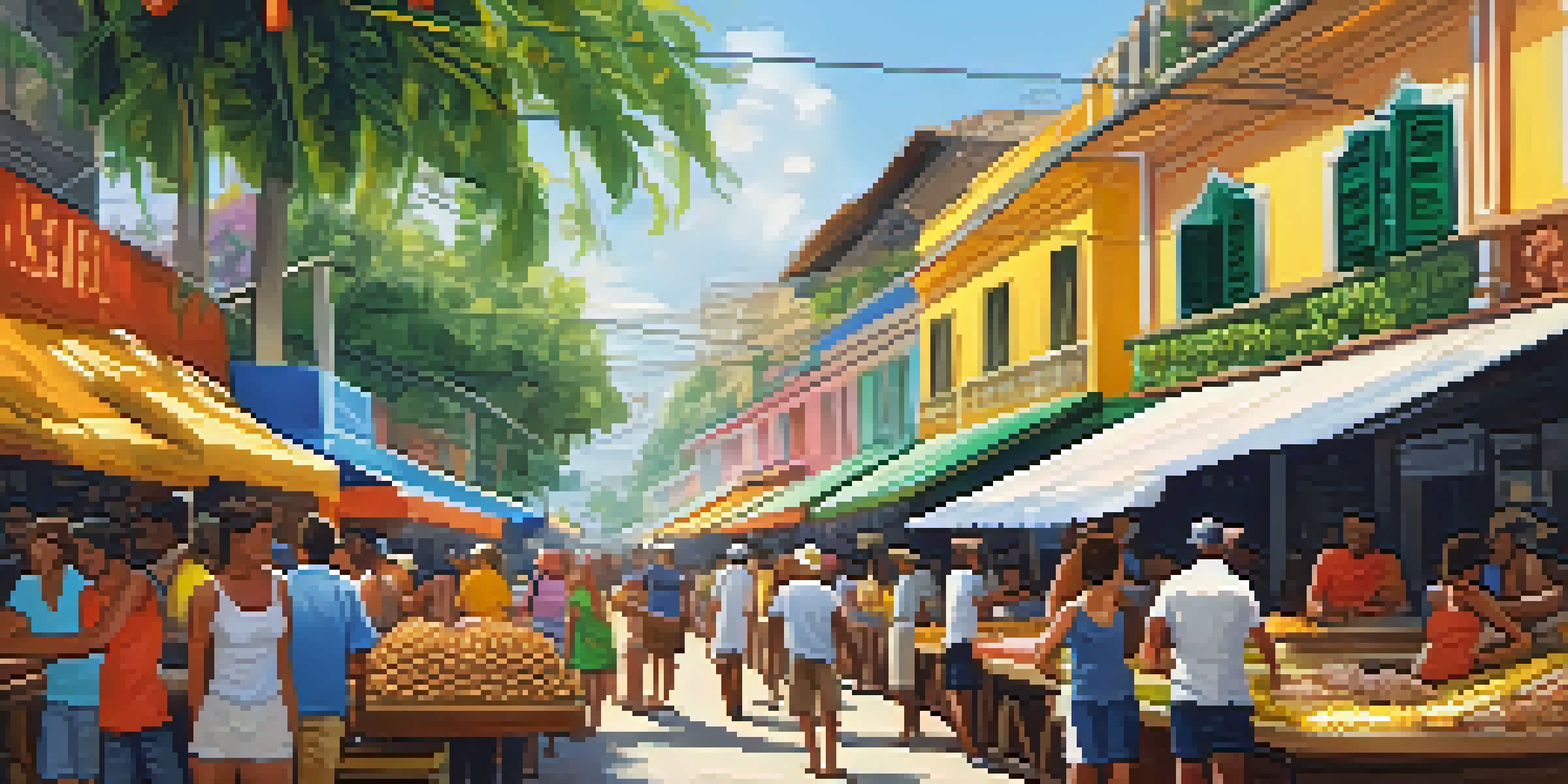Brazilian Cuisine: A Fusion of Cultures and Traditions

The Cultural Melting Pot of Brazil's Culinary Scene
Brazilian cuisine is a vibrant tapestry woven from various cultures, reflecting the nation's rich history. Influences from Indigenous peoples, Portuguese colonizers, African slaves, and immigrant communities have all contributed to this unique culinary landscape. Each group brought their own traditions and ingredients, creating a delicious fusion that is distinctly Brazilian.
Food is our common ground, a universal experience.
For example, the use of cassava, or manioc, is rooted in Indigenous culture, while dishes like feijoada—a hearty black bean stew—draw heavily from Portuguese influences. Meanwhile, the African heritage is evident in foods like acarajé, a black-eyed pea fritter filled with shrimp and spices. This blend of flavors and techniques showcases the dynamic nature of Brazilian cuisine, making it a true cultural melting pot.
As you explore Brazilian dishes, you'll discover how they tell the story of the nation's diverse people and their shared history. Each bite is not just a taste sensation, but also a glimpse into the cultural exchanges that have shaped Brazil into what it is today.
Signature Dishes That Define Brazilian Cuisine
No discussion of Brazilian cuisine is complete without mentioning its iconic dishes. One standout is feijoada, often considered the national dish, which combines black beans with various cuts of pork and beef, simmered to perfection. Traditionally served with rice, collard greens, and orange slices, feijoada is a communal dish meant to be shared, reflecting the Brazilian spirit of togetherness.

Another popular dish is pão de queijo, a cheesy bread roll made from tapioca flour, which is enjoyed as a snack or breakfast treat. Its chewy texture and rich flavor make it a favorite among locals and visitors alike. And let's not forget about brigadeiro, a delightful chocolate truffle that is a staple at Brazilian birthday parties, embodying the country's love for sweets.
Brazil's Cuisine Reflects Its Diversity
Brazilian cuisine is a rich fusion of Indigenous, Portuguese, African, and immigrant influences, showcasing the country's cultural melting pot.
These signature dishes are not just meals; they symbolize Brazilian hospitality and the joy of sharing food with family and friends. Each dish invites you to partake in the communal experience that is intrinsic to Brazilian culture.
Regional Variations: The Diversity of Brazilian Flavors
Brazil's vast size and varied geography lead to significant regional differences in cuisine. In the North, for instance, you'll find dishes that highlight the Amazon's bounty, like tacacá, a soup made from tucupi (a yellow sauce from cassava) and jambu (an herb that numbs the tongue). This region’s cuisine is rich in exotic ingredients that reflect its unique ecosystem.
The best way to understand a culture is to taste its food.
In contrast, the South of Brazil is known for its barbecue culture, particularly the traditional churrasco, where various cuts of meat are grilled over an open flame. This tradition is often accompanied by chimichurri, a zesty sauce that adds a punch of flavor. Each region's distinct approach to ingredients and cooking techniques illustrates how diverse and regional Brazilian cuisine can be.
As you travel through Brazil, you’ll find that each dish tells a story about the land and its people, showcasing the local ingredients and culinary practices that define each area. This regional diversity offers a culinary adventure that is as varied as the country itself.
The Role of Street Food in Brazilian Culture
Street food is an integral part of Brazilian culture, offering a taste of local life and flavors. From bustling markets to beachside vendors, you'll find a variety of quick bites that are both delicious and affordable. Popular options include coxinha, a savory chicken croquette shaped like a teardrop, and pastéis, which are crispy pastries filled with meat, cheese, or vegetables.
These street foods provide not just sustenance, but also a social experience, as people gather to eat, chat, and enjoy their surroundings. Street vendors often become community staples, known for their unique recipes and warm personalities, making them a beloved part of Brazilian life.
Signature Dishes Unite People
Iconic dishes like feijoada and pão de queijo symbolize Brazilian hospitality and the joy of communal dining.
Sampling street food allows you to experience the essence of Brazilian culinary culture in a casual setting. Each bite connects you to the vibrant spirit of the country, where food is not just about nourishment, but also about community and connection.
Brazilian Beverages: More Than Just Refreshments
Beverages in Brazil are as diverse and flavorful as the food itself, offering a refreshing complement to any meal. One of the most famous drinks is caipirinha, a cocktail made with cachaça (a sugarcane spirit), lime, and sugar, which perfectly captures the essence of Brazilian summer. Its simplicity and zest make it a favorite among locals and visitors alike.
Another popular beverage is guaraná, a soft drink made from the guaraná berry, known for its natural caffeine content. It's a refreshing choice that pairs well with various dishes and is often enjoyed during festive occasions. Additionally, for those seeking a non-alcoholic option, coconut water is a staple, offering a tropical and hydrating experience.
These beverages not only enhance the dining experience but also showcase Brazil's rich agricultural diversity. Whether you're sipping a cocktail on the beach or enjoying a refreshing soft drink, Brazilian beverages add another layer of enjoyment to the culinary journey.
The Influence of Modern Cuisine on Traditional Dishes
In recent years, Brazilian cuisine has seen a rise in modern interpretations of traditional dishes, as chefs experiment with flavors and techniques. This culinary evolution often incorporates international influences, creating a fusion that respects tradition while embracing innovation. For example, you might find a contemporary take on feijoada, where chefs use gourmet ingredients and plating techniques to elevate this classic dish.
This trend is not just about reinventing old recipes; it's also about sustainability and using local, organic ingredients. Many chefs are focusing on farm-to-table practices, highlighting the freshness and quality of Brazilian produce. This approach not only supports local farmers but also enhances the flavor profiles of traditional dishes.
Festivals Highlight Food's Importance
Celebrations in Brazil, such as Carnival and Festa Junina, emphasize the role of traditional dishes in fostering community and connection.
As more chefs embrace this modern twist, Brazilian cuisine continues to evolve, attracting attention on the global culinary stage. This blend of tradition and innovation showcases the dynamic nature of Brazilian food culture, ensuring that it remains relevant and exciting for future generations.
Celebrations and Food: A Vital Connection in Brazil
Food plays a central role in Brazilian celebrations, from family gatherings to national holidays. Events like Carnival and Festa Junina are not just about music and dance; they also feature traditional dishes that bring people together. For instance, during Carnival, you'll find street vendors serving up refreshing drinks and tasty snacks, fueling the festivities.
Similarly, Festa Junina, celebrated in June, is marked by dishes like pamonha (corn pudding) and canjica (sweet corn pudding), reflecting the country's agricultural roots. These dishes carry cultural significance and are often prepared using family recipes passed down through generations, creating a sense of nostalgia and connection.

In Brazil, food is more than just sustenance; it is a way to celebrate community, heritage, and shared experiences. Each festival offers a unique opportunity to indulge in traditional flavors while creating lasting memories with loved ones.